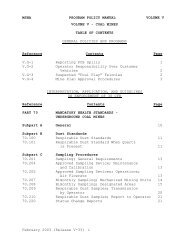Technical Support Report of Surge Bin Tower - Mine Safety and ...
Technical Support Report of Surge Bin Tower - Mine Safety and ...
Technical Support Report of Surge Bin Tower - Mine Safety and ...
Create successful ePaper yourself
Turn your PDF publications into a flip-book with our unique Google optimized e-Paper software.
FIELD INVESTIGATION<br />
2<br />
On November 15 through 18,2010, Michael Superfesky <strong>and</strong> Anthony Argirakis worked with<br />
Sonia Conway, Metal <strong>and</strong> Norunetal <strong>Safety</strong> <strong>and</strong> Health Inspector, Lexington Field Office, by<br />
providing assistance regarding the safe removal <strong>of</strong> the damaged conveyor <strong>and</strong> bin stlUcture. An<br />
additional40·foot <strong>of</strong> new conveyor truss was installed at the end <strong>of</strong>lhe Overl<strong>and</strong> Conveyor so<br />
that a stable cantilever was established until a new bin structure could be installed. Following<br />
the completion <strong>of</strong> this remedial work, the investigation <strong>of</strong> the <strong>Surge</strong> <strong>Bin</strong> <strong>Tower</strong> collapse<br />
commenced. The removal <strong>and</strong> installation <strong>of</strong> the new conveyor structure provided safe access to<br />
the area with little disturbance to the accident scene. A steady rain on November 16,2010, did<br />
produce a light coating <strong>of</strong> rust on the new fracture surfaces <strong>of</strong> the steel.<br />
MSHA was assisted during the investigation in collecting information <strong>and</strong> accessing the accident<br />
scene by the following Hilltop Basic Resources employees.<br />
John Morgan,<br />
Gary Lewis,<br />
Richard Popham,<br />
Kelly Carver,<br />
Configuration <strong>and</strong> Operation<br />
Vice President Mining Operations<br />
General Manager<br />
Quarry Manager<br />
Team Leader<br />
The <strong>Surge</strong> <strong>Bin</strong> <strong>Tower</strong> was configured with an overall height <strong>of</strong> 54 feet <strong>and</strong> square base 0[20.5<br />
feet per side. Photo 1 shows the <strong>Surge</strong> <strong>Bin</strong> <strong>Tower</strong> approximately 5 years prior to the collapse.<br />
The main structural members <strong>of</strong> the tower consisted <strong>of</strong> four columns with lateral bracing<br />
between the columns, a 2-level orthogonal arrangement <strong>of</strong>fIoor girders hung from the bin walls<br />
at the bottom, <strong>and</strong> stiffened bin walls which acted like plate girders (deep beams). The bin was<br />
square with interior dimensions <strong>of</strong> 20 feet by 20 feet <strong>and</strong> a height <strong>of</strong>28 feet. The bin was<br />
constructed by vertically stacking three prefabricated boxed sections (20 feet by 20 feet) together<br />
<strong>and</strong> bolting the box sections at each interface. The 3/4-inch-diameter bolts used for connecting<br />
tIle box sections were installed through the flange plates located on the top <strong>and</strong> bottom <strong>of</strong> each<br />
box section. The walls <strong>of</strong> each box section (bin walls) consisted <strong>of</strong> 1/4-ineh-thick steel plate<br />
stiffened on 2 foot centers using (non-bearing) steel angle sections with dimensions <strong>of</strong> 5 inches<br />
by 3 inches by 114 ineh. At the corners, the walls <strong>of</strong> the bin framed together at 90 degrees <strong>and</strong><br />
were connected using a 1/4-inch fillet weld placed on the inside. The comers <strong>of</strong> the bin were<br />
stiffened for bearing purposes by welding two vertical steel bars (plates) 6 inches by 114 inch at<br />
90 degrees to each other on the outside corners for the full 28-foot height <strong>of</strong> the bin. With<br />
respect to viewing the top <strong>of</strong> the bin from overhead, each corner <strong>of</strong> the bin, with the steel bar<br />
stiffeners attached, formed a cross. The attachment <strong>of</strong> the steel bar stiffeners to the bin corners<br />
helped in transferring the overall bin load (in bearing) to the columns below. The top <strong>of</strong> the<br />
columns had 3/4-inch-thick filler plates welded between both flanges on each side <strong>of</strong> the<br />
column's web to provide a bearing surface to connect the bottom <strong>of</strong> the bin corners <strong>and</strong> the bar<br />
stiffeners to the column. The bottom <strong>of</strong> the bin corners framed on top <strong>of</strong> the columns such that<br />
they interiorly rested upon one quarter <strong>of</strong> the total area provided by the filler plates <strong>and</strong> the<br />
column's web <strong>and</strong> flanges. Framing the bottom <strong>of</strong> the bin corner within an interior quadrant <strong>of</strong><br />
the column top allowed the steel bar stiffeners to be welded to the top <strong>of</strong> the column. The weld

















